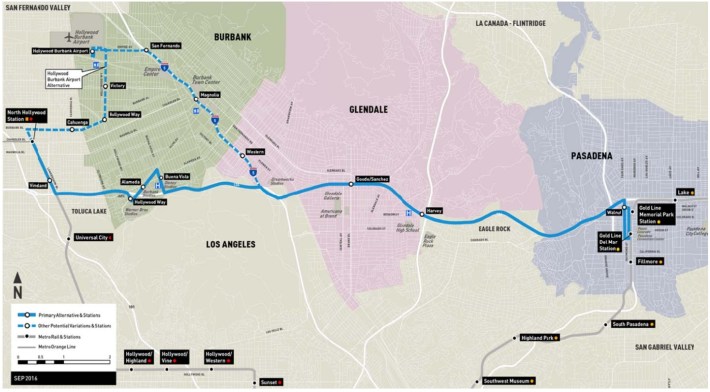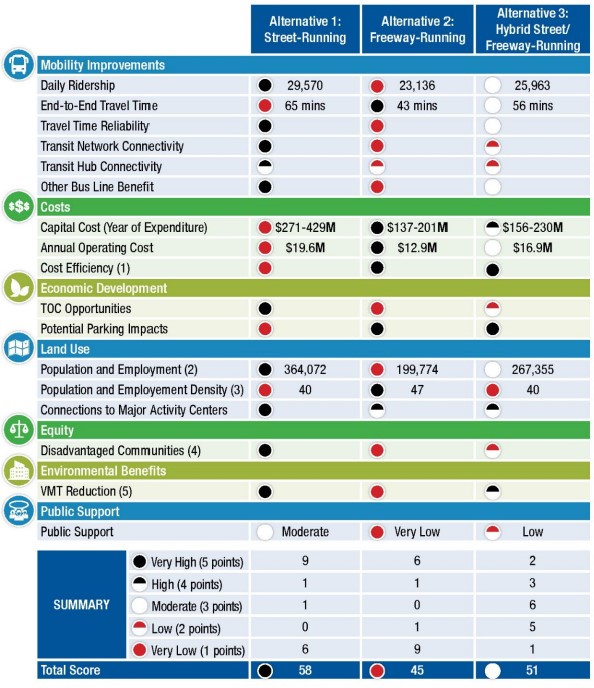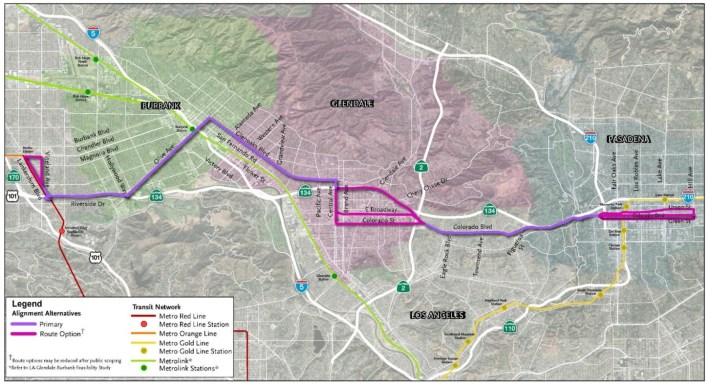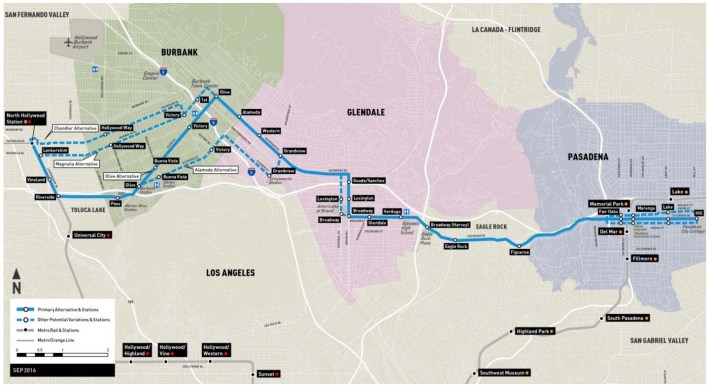Note: Metropolitan Shuttle, a leader in bus shuttle rentals, regularly sponsors coverage on Streetsblog San Francisco and Streetsblog Los Angeles. Unless noted in the story, Metropolitan Shuttle is not consulted for the content or editorial direction of the sponsored content.
Tomorrow [update 4/25: the item was postponed to May], the Metro board will vote on the planned North Hollywood to Pasadena Bus Rapid Transit (BRT) project. The board is expected to approve staff recommendations that call for a primarily street-running route, setting aside an alternative that would have run mostly on freeways.
The NoHo-Pasadena BRT project will extend eighteen miles, connecting the North Hollywood Red/Orange Line station to the Gold Line in Pasadena. The project has $267 million in funding, all from Measure M, which specifies a 2020 groundbreaking and an opening by 2022-2024. It is on the 28 by 2028 list of projects anticipated to be completed for the 2028 Olympics.
Metro has been exploring two primary alternatives: freeway-running and street-running - as well as hybrid versions that combine portions of each.

The not-favored freeway-running alternative would have mostly followed the 134 Freeway. The routing is similar to the existing 501 express bus, which sees fairly low ridership, at about 1,400-1,500 daily boardings on weekdays. Metro's analysis showed that this route would have a shorter end-to-end travel time, but would miss connecting to many local destinations, hence have low ridership.
Several options were under consideration for a route that runs primarily on streets.

Over the past year, Metro held meetings to receive community/stakeholder input. Metro refined various routing choices within the two main alternatives, and completed an alternatives analysis (summary, full report.)
Overall, though street-running is a little slower, and costs a little more, it is expected to attract nearly 30,000 daily riders. Freeway running and partial-freeway alternatives would only draw 23,000 to 26,000 daily riders.

Metro staff have recommended the street-running alternative (above) including Olive Avenue, Glenoaks Boulevard, Colorado Boulevard, and two short stretches on the 134 Freeway: from NoHo into Burbank and in Pasadena just east of Eagle Rock. This alignment would connect with the downtown Burbank Metrolink station and pass within easy walking distance of the Gold Line Memorial Park Station in Pasadena. Some final alignment refinements are still to be decided in the environmental clearance phase. The environmental studies will also determine what BRT features will be included, such as dedicated bus lanes and/or signal prioritization.
Tomorrow, the full Metro board will vote on moving forward with the Environmental Impact Report, with the street-running alignment as the preferred alternative.
At last week's Metro board Planning and Programming Committee Pasadena Mayor Terry Tornek had commented that it could be problematic to extend the BRT east of the Gold Line. Staff's current proposal recommends that the line terminate at Pasadena City College, about a mile and a half east of the Gold Line, but Tornek said that this would duplicate existing bus service on Colorado Boulevard. He said that extending a dedicated bus lane there would be a "terrible mistake" presumably due to parking and/or car lane removal.
Note that some service redundancy (say, between a rail station and a nearby community college) is a good thing for transportation. Roads and Freeways work pretty well in proximity to each other. And, if the city won't prioritize riders, it may still make sense to extend the line to PCC without a full dedicated lane.
Responding to Tornek's concern, Metro staff recommended studying two options: one ending at PCC and one at the Gold Line.
Boardmember John Fasana proposed proceeding, though ending the route at the Gold Line as requested by Tornek. Boardmember Paul Krekorian favored keeping options on the table in the environmental review. Ultimately the committee sent the item to the full board to decide.








